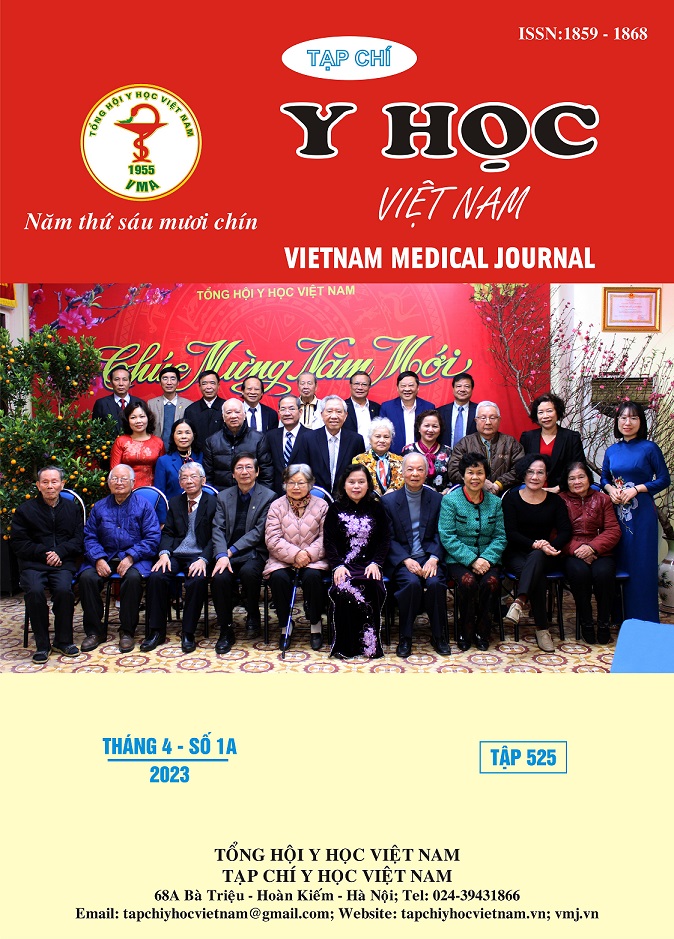INITIAL RESULTS OF LAPAROSCOPIC SURGERY TO TREATMENT INTESTINAL OBSTRUCTION AFTER SURGERY
Main Article Content
Abstract
Background: The study aimed to evaluate the initial results of laparoscopic surgery for intestinal obstruction after surgery at Nghe An Friendship General Hospital and E Hospital. Materials and Methods: Retrospective descriptive study, patients undergoing laparoscopic surgery to treated intestinal obstruction after surgery from 2018 to 2022. Results: There were 35 patients diagnosed with intestinal obstruction after surgery and treated by laparoscopic surgery, the mean age was 45.36 ± 18.63 (16-77) years old, there were 31.4% male and 68.6% were female. The average number of abdominal operations before surgery was 1.29 ± 0.60 times, 80% of abdominal operations were performed once and appendectomy accounted for the majority of 74.3%. The cause of intestinal obstruction is mainly due to ligaments and adhesions, accounting for over 80%. There were 8,6% Assistant-laparoscopic. The mean operative time was 89.80 ± 24.80 (58-138) minutes. There were 5.7% cases had complications of tearing the small bowel muscle during surgery, no complications after surgery. The mean time of post-operative defecation was 2.44 ± 0.77 days, The mean time for beginning oral feeding was 43.56 ± 0.71 (2-5) days. The mean hospital stay was 7.04 ± 1.51 days. Conclusions: Initial results of laparoscopic surgery to treatment intestinal obstruction after surgery show that this is a safe and effective technique, less pain, early recovery, and a short hospital stay.
Article Details
Keywords
Technique of laparoscopic intestinal obstruction, intestinal obstruction after surgery
References
2. Cox. M. R., Gunn. I. F., Eastman. M. C., et al (1993), The safety and duration of non-operative treatment for adhesive small bowel obstruction, Aust N Z J Surg, 63 (5), pp. 367-371.
3. Ayman. M. H., Sarwat. M. A., Naser. Z (2004), Laparoscopic adhesiolysis for recurrurent small bowel obstruction with the ultrasonically activated shear, Egyptian Journal of Surgery, 23 (1), pp. 14-19.
4. V., Wikstrom. H., Victorzon. M., et al (2014), Laparoscopic versus open adhesiolysis for small bowel obstruction - a multicenter, prospective, randomized, controlled trial, BMC Surg, 14 (77), 1471-2482.
5. Nguyễn Văn Hải, Lê Huy Lưu, Nguyễn Hồng Sơn (2008), “Hiệu quả phẫu thuật nội soi trong điều trị tắc ruột sau mổ”, Y Học TP. Hồ Chí Minh, 12(1), 154-160.
6. Đặng Ngọc Hùng (2016), Nghiên cứu chỉ định và kết quả phẫu thuật nội soi điều trị tắc ruột sau mổ, Luận án Tiến sỹ chuyên ngành Ngoại khoa Đại học Y dược Huế tr. 96-115.
7. Nguyễn Hồng Sơn, Nguyễn Văn Hải, Lê Huy Lưu (2010), “Kết quả của phẫu thuật nội soi điều trị tắc ruột sau mổ”, Y Học TP. Hồ Chí Minh, 14 (4), tr. 1-7.
8. Strickland. P., Lourie. D. J., Suddleson. E. A., et al (1999), Is laparoscopy safe and effective for treatment of acute small-bowel obstruction? Surg Endosc, 13 (7), pp. 695-698.


